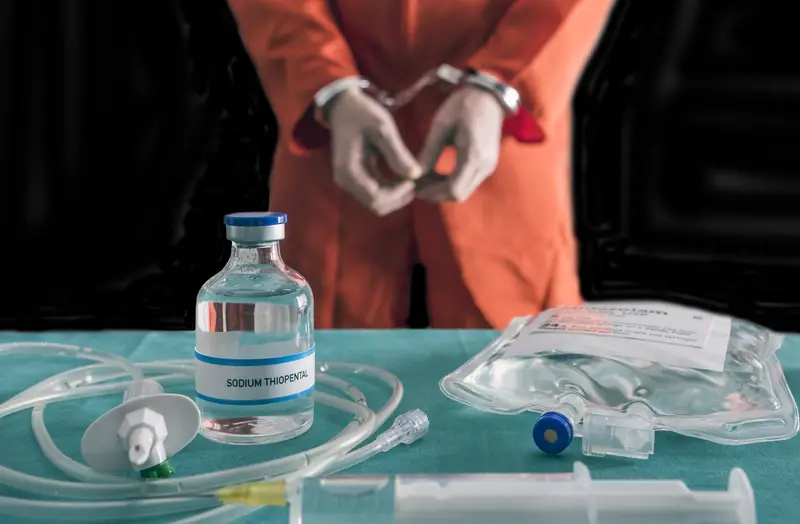The case of Luigi Mangione has captured America’s attention like few others in recent memory. This 26-year-old man stands accused of killing UnitedHealthcare CEO Brian Thompson in New York City last December. Now, U.S. Attorney General Pam Bondi has directed prosecutors to seek the death penalty against him. But what exactly happens next? Many of us have seen movies about death row, but the real process is far more complicated. Let’s look at what Mangione actually faces if he receives a federal death sentence.
The jury must agree unanimously on death
Before Luigi Mangione can be sentenced to death, he must first be found guilty of the federal charges against him. These include using a firearm to commit murder and interstate stalking resulting in death. But a guilty verdict alone doesn’t automatically mean death row. If the jury finds him guilty, they then enter a second phase of the trial focused entirely on deciding his punishment. During this sentencing phase, both sides present evidence about whether the death penalty is appropriate. The prosecution will highlight factors like the “cold-blooded” nature of the killing and any planning involved.
For Mangione to receive the death penalty, every single juror must vote for it. If even one juror votes against death, he will receive life in prison instead. We saw this happen recently in the case of Sayfullo Saipov, who was found guilty of murdering eight people in New York in 2017. Despite the horrific nature of his crimes, at least one juror refused to vote for the death penalty, resulting in a life sentence. This requirement for jury unanimity is one of the biggest hurdles prosecutors face when seeking execution, and it’s why many federal death penalty cases end with life sentences instead.
Years of appeals will follow any death sentence
If Mangione does receive a death sentence, his case is far from over. Every death sentence automatically triggers appeals that typically last for years or even decades. His lawyers will file a direct appeal to challenge the verdict and sentence, arguing that errors occurred during the trial. They might claim evidence was improperly admitted, jury instructions were flawed, or that the prosecution engaged in misconduct. This direct appeal goes to the U.S. Court of Appeals and potentially to the Supreme Court, a process that alone can take 2-5 years. Even if these appeals fail, Mangione’s legal team would then start filing habeas corpus petitions challenging the constitutionality of his confinement.
These appeals aren’t just formalities – they frequently succeed in overturning death sentences. Between 1973 and 2022, about 185 people who received death sentences in the U.S. were later exonerated through appeals. Death penalty cases receive intense scrutiny from appellate courts precisely because the punishment is irreversible. During these years of appeals, Mangione would remain on death row but would not face imminent execution. The appeals process is so lengthy that some death row inmates die of natural causes before their appeals are exhausted. If Mangione receives the death penalty at age 26, he might not face execution until his 40s or 50s.
Death row conditions are harsh and isolating
While his appeals move through the courts, Mangione would be held in the Special Confinement Unit at the U.S. Penitentiary in Terre Haute, Indiana. This is where all male federal death row inmates are housed. Life there is extremely restricted compared to regular prison. Inmates typically spend 23 hours per day in their cells, with just one hour for exercise in a small, enclosed area. Cells are approximately 8 by 10 feet, containing a concrete bed, sink, toilet, and small desk. Personal possessions are strictly limited. Meals are delivered to the cell, and all movements outside the cell require restraints and escort by multiple guards.
Contact with the outside world is severely limited. Death row inmates can receive visitors, but these visits occur through glass barriers with no physical contact allowed. Phone calls are monitored and restricted to approved numbers, usually just immediate family and lawyers. The psychological impact of these conditions is severe. Studies show that death row inmates frequently develop mental health problems including depression, anxiety, and psychosis due to the extreme isolation. Some death row inmates have reported that the psychological torture of waiting for death for years is worse than the execution itself. Mangione would likely spend at least ten years in these conditions while his appeals move forward.
Political changes could affect his sentence
One of the most unpredictable aspects of Mangione’s case is how changes in political leadership might affect his fate. Federal executions are carried out under policies set by the president and attorney general, and these policies can change dramatically between administrations. We’ve seen this happen recently. The Trump administration resumed federal executions in 2020 after a 17-year pause, carrying out 13 executions in just six months. Then the Biden administration imposed a moratorium on federal executions and later commuted the sentences of 37 out of 40 federal death row inmates to life in prison without parole before leaving office.
Now with Trump back in office and Attorney General Bondi directing prosecutors to seek the death penalty, the federal government is again pursuing executions. But what happens if a future president opposes the death penalty? They could impose a new moratorium or even commute Mangione’s sentence to life in prison. This political dimension creates enormous uncertainty about whether a death sentence would ever be carried out. Given that appeals in death penalty cases often take 15-20 years, Mangione’s case could span multiple presidential administrations with different approaches to capital punishment, making his ultimate fate even more uncertain.
Most death sentences never result in execution
The reality is that most people sentenced to death in America are never actually executed. According to the Death Penalty Information Center, only about 16% of people who received death sentences since 1977 have been executed. Most had their sentences reduced on appeal, died of natural causes while appeals were pending, or are still on death row awaiting final resolution of their cases. This trend is even more pronounced in federal cases. Before the 13 executions carried out in 2020-2021, the federal government had executed only three people in the previous 50 years. With Biden’s commutations, there are currently only three prisoners on federal death row.
So even if Mangione receives a death sentence, statistics suggest he is more likely to die of natural causes than by execution. The immense costs of capital cases also work against execution. Housing someone on death row costs about two to three times more than in regular prison due to increased security requirements. When combined with the legal costs of endless appeals, a death sentence can cost taxpayers millions more than a life sentence. These practical considerations, along with changing public attitudes about the death penalty, mean that a death sentence is often more symbolic than a prediction of actual execution.
The execution process itself is clinical and quick
If all appeals fail and no political interventions occur, Mangione would eventually face execution. Federal executions take place at the death chamber in Terre Haute, Indiana. In the days leading up to execution, the condemned person is moved to a special holding cell adjacent to the execution chamber. They are allowed special last meal requests (within reason) and final visits with family, spiritual advisors, and attorneys. When the time comes, the prisoner is strapped to a gurney and IVs are inserted into both arms. Witnesses, including family members of both the victim and the condemned, journalists, and prison officials, watch from behind glass.
The federal government uses lethal injection, typically a three-drug protocol. First, a sedative renders the person unconscious. Next, a paralytic agent stops all muscle movement and breathing. Finally, potassium chloride stops the heart. Death usually occurs within 7-10 minutes after the drugs begin flowing. However, botched executions where the drugs don’t work as intended have occurred. In these cases, inmates have sometimes remained conscious and in apparent pain. This is partly why the drugs used in lethal injections have become controversial, with many pharmaceutical companies refusing to provide them for executions. The shortage of execution drugs has led to delays and changes in protocol that might affect Mangione if his execution date ever arrives.
State charges complicate the situation
Adding another layer of complexity to Mangione’s case is that he faces both federal and state charges. New York has charged him with first-degree murder and “murder as a crime of terrorism,” among other counts. If convicted of these state charges, he would face a maximum sentence of life in prison without parole, since New York abolished the death penalty in 2007. This creates a situation where Mangione could be sentenced to death federally while also receiving a life sentence from New York state. In such cases, authorities must decide which jurisdiction gets priority in housing the prisoner.
Typically, the federal government would get priority, meaning Mangione would go to federal death row regardless of his state sentence. However, there have been cases where states have fought to maintain custody of high-profile criminals. This jurisdictional tug-of-war could further complicate and delay any potential execution. It also means that even if the federal death sentence were somehow overturned on appeal, Mangione would still face life in prison without parole under the New York sentence. Some legal experts have questioned why federal prosecutors are even pursuing the death penalty given this reality, suggesting the decision may be more political than practical.
Victims’ families face years of painful court proceedings
While much attention focuses on Mangione, it’s important to remember that a death penalty case also has profound effects on the victims’ families. For Brian Thompson’s family, a death sentence would not mean quick closure. Instead, it would mean decades of painful court proceedings, appeals, and media attention. Many victims’ families report that the constant reminders of their loss during drawn-out capital cases actually prevent healing. Each new appeal or hearing forces them to relive the crime and delays any sense of finality. Some families of murder victims have even come to oppose the death penalty for this reason, preferring the relative closure of a life sentence without possibility of appeal.
Studies show that victims’ families in cases where the death penalty is sought experience higher rates of post-traumatic stress and complicated grief compared to those in cases where life imprisonment is the sentence. The Thompson family would face not only their private grief but also the public spotlight that accompanies high-profile death penalty cases. Their pain would be magnified by the political dimensions of this case, as Mangione has become a symbol for some people angry about the American healthcare system. This added layer of public debate about what their loved one represented would likely add to their suffering during the lengthy legal process.
The path from death sentence to execution is long, uncertain, and filled with legal hurdles. Even if Luigi Mangione receives the federal death penalty, he would likely spend decades on death row while appeals work through the courts. Changes in political leadership could dramatically alter his fate, potentially resulting in a commutation to life imprisonment. And given the statistics on death sentences that never result in execution, Mangione is more likely to die of natural causes than by lethal injection. The death penalty in America today is less a swift punishment than the beginning of a marathon legal process with an uncertain end.

